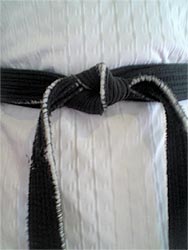

Tae Kwon Do Forms (Patterns)
The Forms, or Hyungs, of Taekwondo make up the backbone of the art. After learning the basic blocks, punches, stances, and postures of Taekwondo, the student begins the study of the Hyungs. Over the years, different schools have developed different forms. Our forms are called the Chang-Hon (Blue Cottage) Hyungs, named for the Founder's penname. The Chang-Hon (sometimes called the Chon-ji) forms are considered the most traditional, the oldest in the style, created by the Founder. In our style of Taekwondo (called Moo Duk Kwan) there are twenty-four forms, symbolizing the number of hours in the day. Each form is more complex than the one before it, training the student step by step, opening his or her understanding of the art as the months and years go by.
- Chon-Ji (19) Literally means Heaven and Earth. The logical place for the beginner, the ground to stand on and the room to grow. The form has two parts, one symbolizing the Earth, the other Heaven.
- Tan-Gun (21) Named for the Founder of Korea, in the year 2333 B.C.
- To-San (24) Named for the patriot who devoted his entire life to furthering the education of Korea (1876-1938).
- Won-Hyo (28) Named for the monk who introduced Buddhism to the Shilla Dynasty, 686 A.D.
- Yul-Go (38) The penname of the philosopher and scholar Yi I (1536-1584) nicknamed the Confucius of Korea.
- Joong-Gun (32) Named for the patriot who assassinated the first Japanese Governor-General of Korea.
- Toi-Gye (37) Penname of the scholar Yi-Hwang (16th A.D.), an authority of neo-confucianism.
- Hwa-Rang (29) Named for the Hwa-Rang youth group, born in the Shilla Dynasty, 1350 years ago.
- Choong-Mu (31) Given name to the great Admiral Yi Sun-Sin of the Yi Dynasty.
- Kwang-Gae (39) Named for the 19th King of the Koguryo Dynasty, who regained lost territories in Manchuria.
- Po-Eun (30) Named for a famous poet and pioneer in physics (1400 A.D.) whose saying "I would not serve a second master though I might be crucified a hundred times" is known to every Korean.
- Ge-Baek (42) Named for General Ge-Baek, of the Baek-Je Dynasty (660 A.D.)






